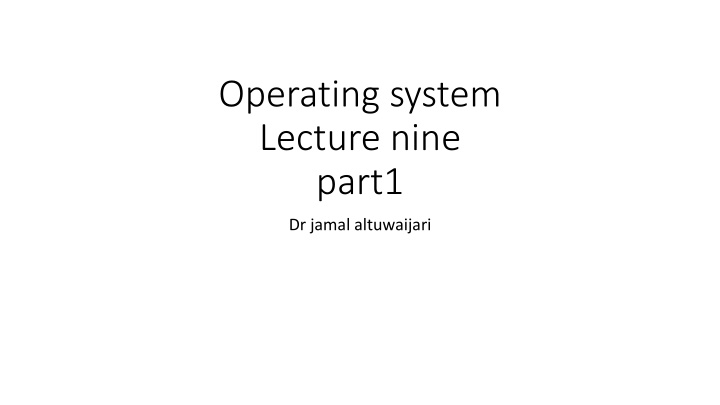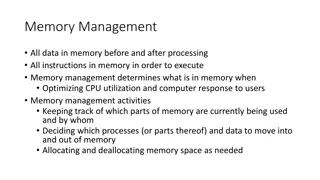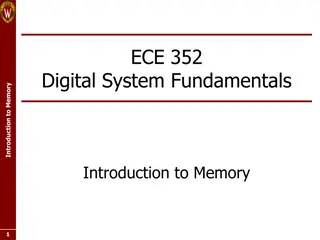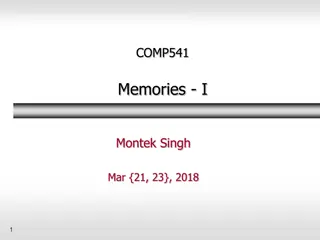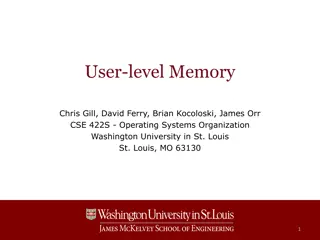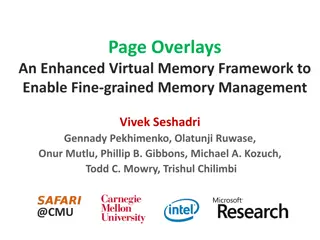Memory Management Strategies in Operating Systems
Memory management in operating systems involves organizing and managing main memory efficiently. It includes strategies like fetch, placement, and replacement to optimize the usage of main storage resources. Allocation methods such as bare machine and single-user contiguous storage play a crucial role in managing programs and data effectively. Understanding contiguous vs. non-contiguous storage allocation is essential for efficient memory management.
Download Presentation

Please find below an Image/Link to download the presentation.
The content on the website is provided AS IS for your information and personal use only. It may not be sold, licensed, or shared on other websites without obtaining consent from the author.If you encounter any issues during the download, it is possible that the publisher has removed the file from their server.
You are allowed to download the files provided on this website for personal or commercial use, subject to the condition that they are used lawfully. All files are the property of their respective owners.
The content on the website is provided AS IS for your information and personal use only. It may not be sold, licensed, or shared on other websites without obtaining consent from the author.
E N D
Presentation Transcript
Operating system Lecture nine part1 Dr jamal altuwaijari
9 9. Memory Management . Memory Management 9.1 Introduction. The organization and management of the main memory or primary, or real memory of a CIS has been one of most important factors influencing 0/S design, programs and data need to be in main storage in order to be executed or referenced, and if they do not needed immediately may be kept on secondary storage media such as tapes or disk until needed and then brought into the main storage for execution or reference. The figure 9.1 show the typical storage hierarchy. Figure 9.1: Hierarchical storage organization
9.2 9.2 Storage management Storage management strategies strategies There are many strategies are used to obtaining the best possible use of the main storage resource, and some of these strategies are: A. Fetch strategies are concerned with when to obtain the next piece of program or data for transfer to main storage from secondary storage. Deimand fetch strategies in which the next piece of program or data is brought into the main storage when its referenced by a running program. Anticipatory fetch strategies makes predict and guesses and anticipating the future where program control will go next. B. Placement strategies are concerned with determining where in main storage to place a new program, we shall consider the first fit, best fit, and worst fit storage placement strategies C. Replacement strategies are concerned with determining which piece of program or data to displace to make room for a new program.
9.3 9.3 Contiguous V S non Contiguous V S non contivrous contivrous storage allocation allocation storage The continuous allocation means each program occupy a single contiguous block of storage locations. In non continuous storage allocation, a program is divided into several blocks or segments that may be placed through out main storage in pieces not necessary adjacent to one another. It is more difficult for an OS to control (non contiguous storage allocation).
9.4 9.4 Allocation Allocation methods methods There are many methods used to organize and allocate storage to user programs and data some of these are: 9.4.1 Bare machine The user has complete control over the entire memory space, and can use the memory in flexible manner. This method is simple and not require any cost, and not need any special H/V or S/W. 0 32k Memory Figure 9.2 User
9.4.2 9.4.2 Single user contiguous storage Single user contiguous storage allocation allocation The earliest C/S allowed only a single user at a time to use the machine. Where the memory is divided into two sections one for the user and one for the 0/S as in the figure 9.3 below. User 0 a User Un used b Figure 9.3: Single user contiguous storage allocation
9.4.2 9.4.2 Single user contiguous storage allocation Single user contiguous storage allocation In this scheme programs are limited in size to the amount of main storage. The protection H/W is use the fence address to protect the O/S and the user program where every user address is compared with the fence address if>_ the fence the address is correct else indicate an error. See the figure 9.4 below. Figure 9.4: H/W address protection for a R.M
9.4.2 9.4.2 Single user contiguous storage allocation Single user contiguous storage allocation In the case of CVS size changes during program execution. There two way to modify the basic scheme: a. The user program is loaded into high memory down to wards the fence rather than from the fence toward high memory. The advantage here is that all unused space is in the middle and either the user or the 0/S can expand into this unused memory as necessary, see the figure 9.5. b. A more general approach used is to delay
9.4.2 9.4.2 Single user contiguous storage allocation Single user contiguous storage allocation address binding until execution time. dynamic relocation scheme requires different H/\V support as in the figure 9.6. Figure 9.5: Loading user into HAY The fence register is now called the relocation or base register and are the Value of this register is added to every address generated by a user process at the time it is sent to memory, see the figure 9.6 below.
9.4.2 9.4.2 Single user contiguous storage allocation Single user contiguous storage allocation Figure 9.6: Dynamic relocation using a base register or relocation register. Now we have two different types of addresses logical addresses 0 > mix and physical addresses R+0 > R max (R fence value). The user only generate the logical addresses.
9.4.3 9.4.3 Overlays allocation methods Overlays allocation methods The size of program (process) can be larger than the a mount of memory allocated to it, a technique called overlays is sometimes used. The idea of overlays is to keep in memory only those instruction and data that are needed at any given time. When other instruction are needed they are loaded into space that was occupied previously by instruction that are no longer needed.
9.4.3 9.4.3 Overlays allocation methods Overlays allocation methods . Example Consider a two pass assembler:' During pass 1 it constructs symbol table then during pass 2 it generates inachine languages code. We may able to partition such as assembler into pass I code, pass 2 code the symbol table and common support routines used by both pass 1 and pass 2. Assume the size of these components are as follows: Pass 1 = 70 KB. Pass 2 = SO KB S. Table = 20 KB. Common routines = 30 KB To load every thing at once we require 200 KB of memory. If only 150 KB is available we cannot run our process. But that pass I and pass 2 do not used to be in memory at the same time, so we can define two overlays: A =Pass 1+ S.T.+ C.R = SO + 20 + 30 = 130 B= Pass 2+ S.T.+ C.R = 70 + 20 + 30 = 120 See Figure 9.7.
9.4.3 9.4.3 Overlays allocation methods Overlays allocation methods Figure 9.7: Overlays for two- pass assembler
9.4.3 9.4.3 Overlays allocation methods Overlays allocation methods Logical versus physical address space An address generated by the CPU is commonly referred to as a logical address. where as an address seen by the memory unit is commonly referred to as a physical address. The compile time and load time address binding scheme result in an environment where the logical and physical addresses are the same, and these two addresses at execution time are differ. The set of all logical addresses generated by the program is referred to as a logical address space, the set of all physical addresses corresponding to these logical addresses is referred to as a physical address space. The run time mapping from virtual to physical addresses is done by the Memory Management Unit (MMU) which is the H/W device.
9.4.4 9.4.4 Swapping allocation Swapping allocation method method A process can be swapped temporarily out of memory to a backing store and then brought back into memory for continued execution swapping requires a backing store is commonly a fast disk and must be large enough to accommodate copies of all memory images.
9.5 9.5 Multiple Multiple- -Partition Allocation Partition Allocation Because it is desirable in general that there be several user processes residing in memory at the same time we need to consider the problem of how of allocate available memory to the various processes that are in the input queue waiting to be brought into memory. The memory is divided into a number of regions or partitions. Each region have one process. There are two major memory management schemes are possible.
9.5.1 9.5.1 Multinle Multinle contiguous fixed volition (MFT) contiguous fixed volition (MFT) The memory is divided into a number of fixed sized partitions. Each one contain exactly one process. Thus the degree of multi programming is bound by the number of partitions. \Vhen the partition is free the processing selected from the input queue and is loaded into the free partition. When the process terminated the partition becomes available for another process. Protection H/W The protection can be provided by using two resisters as in figure 9.9: i. Bounds registers: The values of the smallest and largest physical addresses. ii. Base and limit registers. The value of the smallest physical address and the range of logical addresses.
Figure 9.9: Multiple Partitions Leat user address range from 0 to the limit and dynamically relocated to physical to physical addresses ranging from base to base limit. See the diagrams below 9.10. (a) Trap to O/S- addressing error
(b) Trap addressing error Figure 9.10: (a) Bounds registers and (b)Base / Limit registers . With MET for example if we have three partitions of size 2K, 6K, and 12K weneed three queues Q2, Q6 and Q12. An incoming job requiring 5K of memory would be appended to Q6, a new job needing 10K put in Q12 a job of 2K go in Q2. See the figure below.
OS 2K 6K 12K MFL with one queue memory
9.5.2 Multiple contiguous variable partition (MVT 9.5.2 Multiple contiguous variable partition (MVT) ) The main problem with MFT is not allocate the best available memory space size (memory blocks) to the smallest internal and external space. The solution to this problem is to allow to the size of partition to be dynamically variable. This method is called Multiple Contiguous Variable Partition (MVT). In this method, the operating system keeps a table indicating which parts of memory are available and which are occupied. Initially, all memory is available for user processes and is considered one large block of available memory, a hole. As processes enter the system, they are put into an input queue. The operating system takes into account the memory requirements of each process and the amount of available memory space in determining which processes are allocated memory. The disadvantage of this method is the internal and external fragmentation, which lead to bad utilization of memory.
Storage placement strategies . These strategies are used to determine where in the main storage to place incoming programs and data, three strategies are used: i.Best Fist strategy: An incoming job is placed in the smallest hole in main memory big enough. We must search entire list unless the list is kept ordered by size. ii. First Fit: Allocate the first hole that is big enough searching can start either at the beginning of the set of holes or where the previous first fit search ended. Searching stop as soon as we find a free hole that is large enough. iii. Worst Fit: Allocate the largest hole. Again we search entire the list unless it is sorted by size. Simulation indicate both First Fit and best fit are better than worst fit in terms of decreasing both time and storage utilization.
Storage placement strategies Figure 9.12: the use of placement strategies.
fragmentation fragmentation A job which needs in words of memory may be run in a region of n words, where n > m. The difference between these two number (n-m) is internal. Fragmentation memory which is internal to a region but is not being used. External Fragmentation occurs when a region is unused and available but too small for any waiting job. Both types of fragmentation are sources of memory waste in MFT. F = IF + EF
Compaction Compaction One solution to fragmentation is compaction. The goal is to shuffle the memory contents to place all free memory together in one large block. Compaction is not always possible when it is possible we must determine its cost. The simplest compaction algorithm is to move all jobs towards one end of memory all holes move in the other direction, producing one large hole of available memory, see figure 9.13 below. Figure 9.12: Compaction process.
